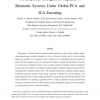Free Online Productivity Tools
i2Speak
i2Symbol
i2OCR
iTex2Img
iWeb2Print
iWeb2Shot
i2Type
iPdf2Split
iPdf2Merge
i2Bopomofo
i2Arabic
i2Style
i2Image
i2PDF
iLatex2Rtf
Sci2ools
TIFS
2008
2008
On Empirical Recognition Capacity of Biometric Systems Under Global PCA and ICA Encoding
Performance of biometric-based recognition systems depends on various factors: database quality, image preprocessing, encoding techniques, etc. Given a biometric database and a selected encoding method, the capability of a recognition system is limited by the relationship between the number of classes that the recognition system can encode and the length of encoded data describing the template at a specific level of distortion. In this work, we evaluate empirical recognition capacity of biometric systems under the constraint of two global encoding techniques: Principal Component Analysis (PCA) and Independent Component Analysis (ICA). The developed methodology is applied to predict capacity of different recognition channels formed during acquisition of different iris and face databases. The proposed approach relies on data modeling and involves classical detection and information theories. The major contribution is in providing a guideline on how to evaluate capabilities of large-scal...
| Added | 15 Dec 2010 |
| Updated | 15 Dec 2010 |
| Type | Journal |
| Year | 2008 |
| Where | TIFS |
| Authors | Natalia A. Schmid, Francesco Nicolo |
Comments (0)

